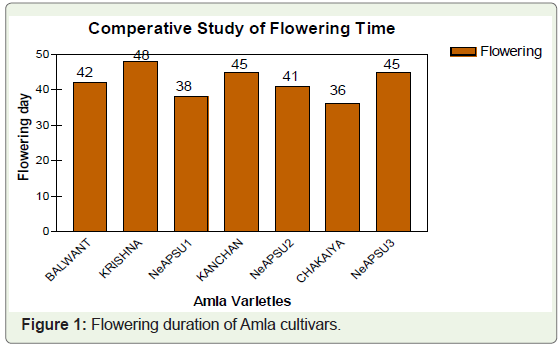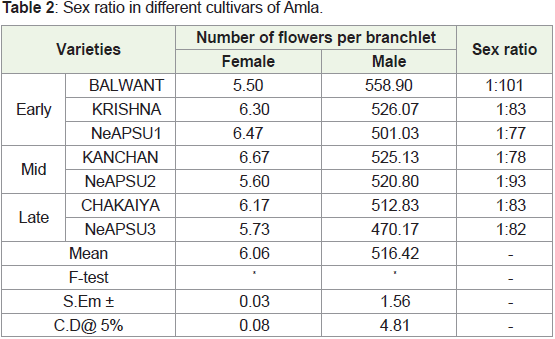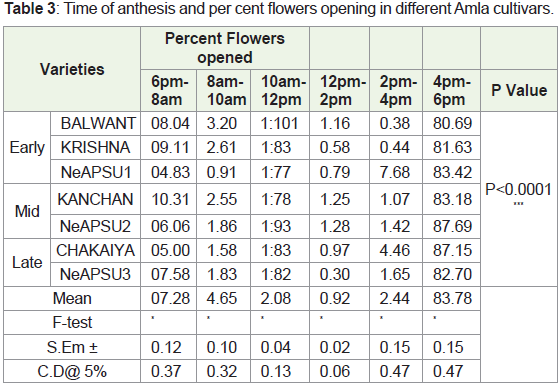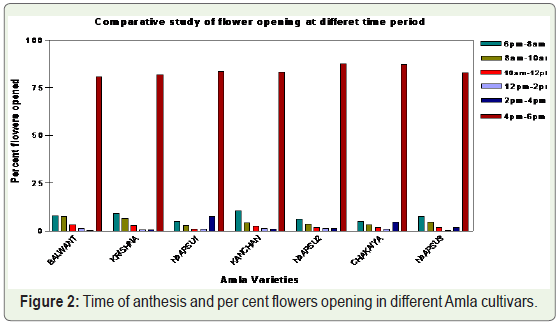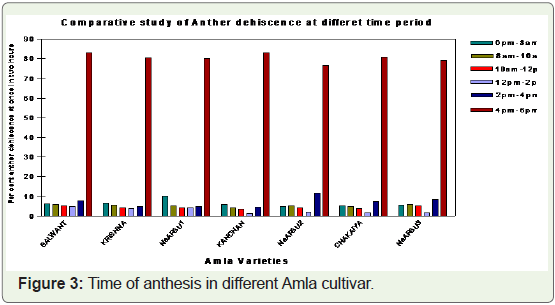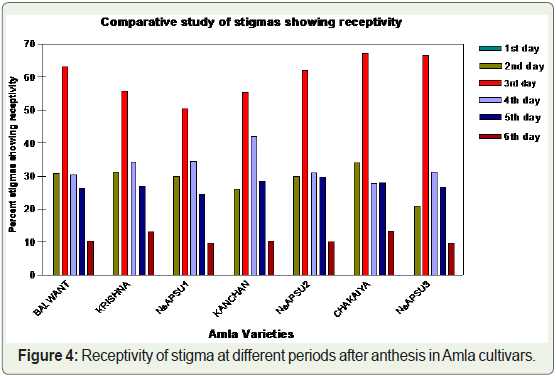Research Article
Flowering Behaviour Studies in Some Selected Cultivars of Amla (emblica officinalis gaertn.) Under Vindhyan Region
Charmkar NK1* and Singh R2
1Department of Botany, Government College Bakswaha (MCBU), Chhatarpur, M.P, India
2College of Agriculture, Rewa (M.P.), India
*Corresponding author: Charmkar NK, Department of Botany, Government College Bakswaha (MCBU) Chhatarpur,
M.P., India; E-mail: kumarneerajbt89@gmail.com
Copyright: © Charmkar NK, et al. 2022. This is an open access article distributed under the Creative Commons Attribution License,
which permits unrestricted use, distribution, and reproduction in any medium, provided the original work is properly cited.
Article Information: Submission: 18/06/2022; Accepted: 20/07/2022; Published: 25/07/2022
Abstract
Amla or Indian gooseberry (Emblica officinalis Gaertn. Syn. Phyllanthus emblica L.), belongs to the ancestors Euphorbiaceae and is an important
aboriginal fruit crops of Indian subcontinent. Fourteen years old trees of seven cultivars viz., NA-10 (Balwant), NA-5 (Krishna), NA-4 (Kanchan), Local
Variety (NeAPSU1), Chakaiya, Local Variety (NeAPSU2) and Local Variety (NeAPSU3) were included for the study. Reproductive behaviour studies include
all vegetative parameters, floral biology and fruiting pattern. This experiment work includes flowering Inflorescence type & its colour, budding & blooming,
anthesis & its dehiscence. The duration of blooming also varied with the cultivar. Blooming aeon lasted for 36 (cv. Chakaiya) to 48 days (cv. Krishna). The
beggarly best amounts of Male flowers were empiric in the cultivar Balwant and the least amount was empiric in the NeAPSU3. The best amounts of female
flowers were empiric in cultivar Kanchan and atomic was empiric in cultivar Balwant. Sex ratio (male: female) was begin to alter from 77:1 (cv. NeAPSU1)
to 101:1 (cv. Balwant).
Keywords
Indian gooseberry; Cultivars; blooming; dehiscence; Inflorescence
Introduction
Emblica officinalis Gaertn. Syn. Phyllanthus emblicaL. (popular
known as Amla or Aonla or Indian gooseberry) is an ephemeral tree
belonging to the Euphorbiaceae family. Aonla fruits are edible and
are mainly found in regions of India, Southeast Asia, China, Iran, and
Pakistan. According to ancient Indian historical mythology, this is
the first tree to be “produced in the universe” [1-12]. Aonla has an
important role in the traditional medicine of India to reduce anxiety
and burning sensation in skin and eyes, improve liver health, improve
anemic condition, favor the health of the male reproductive system
and reproduction, facilitate digestion and also exert a tonic effect in
the cardiovascular system. The wild amla is small while cultivated
amla is big, smooth and juicy. Chemical composition of the amla fruit
contains more than 80% of water. It also has protein, carbohydrate,
fiber and mineral and also contains Gallic acid which is a potent
polyphenol. Vitamin C is important for human beings [13-15]. It is allimportant
for the amalgam of the inter-cellular cementing actuality
which is amenable for befitting the beef of the physique together.
The amla fruit appear to accommodate about 20 times as abundant
vitamin C as orange juice. The comestible amla fruit tissue has 3
times the protein concentration and 160 times the ascorbic acerbic.
The fruits of Emblica officinalis are widely used in the Aryuveda and
are believed to increase defense against diseases. It has its beneficial
role in cancer, diabetis, liver treatment, heart trouble, ulcer, anemia
and various other diseases. Similarly, it has application as antioxidant,
immunomodulatory, antipyretic, analgesic, cytoprotective, antitussive
and gastroprotective. Additionally, it is useful in memory enhancing,
ophthalmic disorders and lowering cholesterol level. It is also helpful in neutralizing snake venom and as an antimicrobial. It is often used
in the form of Triphla which is an herbal formulation containing fruits
of Emblica officinalis, Terminalia chebula and Terminalia belerica in
equal proportions. Beside this Emblica officinalis is a rich source of
vitamin C. Some of the plant has only male, female or Hermaphrodite
flower and some plant has all three types of flower on the same plant.
These reproductive characters greatly influence the productivity of
Emblica officinalis [16-21].
In India, abundant assortment of Amla is accessible in the
backwoods breadth of Vindhyan hills, lower hills of Uttarakhand
and Himachal Pradesh, Chhattisgarh, Jharkhand, Madhya
Pradesh, Rajasthan and Bihar. Krishna, Banarasi, Chakaiya, Francis
(Hathijhool), Kanchan (NA-4), NA-6, NA-7, Anand-1, 2 and 3 are
some of the commercially able varieties of Amla [22-25]. So this
investigation was done to find out the flowering & fruiting behaviour
of some selected local cultivars of Amla found under Vindhyan region.
Materials & Methods
The present study was carried out at Centre for Biotechnology
studies, A.P.S. University Rewa and Department of Horticulture,
College of Agriculture Rewa (M.P.) during the year 2014-2019. Amla
trees of different varieties of the same age were selected and all the
horticultural techniques and practices were carried out uniformly
throughout the period of experimentation. Fourteen years old trees
of seven cultivars viz., NA-10 (Balwant), NA-5 (Krishna), NA-4
(Kanchan), Local Variety (NeAPSU1), Chakaiya, Local Variety
(NeAPSU2) and Local Variety (NeAPSU3) were included for the
study. The materials include varietal description, vegetative body
parameters, floral biology including blooming, anthesis and their
dehiscence.
Results and Discussion
Amla (Emblica officinalis Gaertn.) tree bears two types of shoot
viz., indeterminate (long) and determinate (short) shoots. The
determinate shoots (branchlets) were either barren or floriferous with
embricate leaves. Floral buds appeared as tiny pin heads on slender
branchlets which were produced on woody branches, irrespective of
their age in the middle of January when the tree is leafless. The nature
of inflorescence was racemes type in all the cultivars. Male flowers
appeared in clusters in the leaf axils all over the branchlets while
female flowers were born on the upper end of the branchlet. A typical
flower consists of perianth and androecium or gynoecium. Male
flowers were baby and hardly blush in the bud date but at anthesis,
they angry buttery white.
Flowering Characters
Full Bloom:
Variety NeAPSU1 exhibited full bloom as early as 16 days from
the flower initiation followed by Kanchan (17 days), Krishna and
NeAPSU2 (18 days). While the cultivar Balwant, Chakaiya, NeAPSU3
attained full bloom at 20, 22 and 24 days respectively (Table 1, Figure 1).Duration of flowering:
Maximum duration of flowering was recorded in Krishna (48
days) followed by NeAPSU3 & Kanchan (45 days), Balwant (42
days), NeAPSU2 (41 days) and minimum duration of flowering was
recorded for Chakaiya (36 days) followed by NeAPSU1 (38 days)
(Table 1, Figure 1).Floral morphology:
Data on floral morphology features like colour of inflorescence,
number of flowers per branchlet and number of flowers per cluster
in male and female flowers for all the cultivars were recorded and the
results are presented in Table 1.Colour of inflorescence:
Deep pink colour of inflorescence was observed in Balwant,
Krishna and Chakaiya cultivars. Pinkish green coloured inflorescence
was observed in Kanchan, NeAPSU1, NeAPSU2 and local NeAPSU3
(Table 1).Number of male flowers per branchlet:
Male flowers per branchlet were maximum in Balwant (399-756)
followed by Krishna (475-729), NeAPSU2 (429-724), NeAPSU1 (450-
702), NeAPSU3 (356-695) and Kanchan (392-675), while the least number of flowers per branchlet was observed in Chakaiya in the
range of 384-674 (Table 2).Number of male flower per cluster:
Maximum range of male flower per cluster was recorded in
Krishna (10-18), followed by Balwant (7-15), NeAPSU2 (7-14),
NeAPSU3 (6-13) and NeAPSU1 (5-12), while the least range of male
flowers per cluster was observed in Kanchan (5-11) followed by Chakaiya (6-11) (Table 2).Average number of female flowers per branchlet:
The average number of female flower per branchlet was highest
in the Krishna (6.89) followed by Kanchan (6.54), NeAPSU1 (5.91),
NeAPSU2 (5.64), Balwant (5.2) and NeAPSU3 (4.72), while least
number of female flowers per branchlet was observed in Chakaiya
(4.35) (Table 2).Average number of female flower per cluster:
The average range of female flower per cluster ranged in between
one to two in all the six cultivars of amla including the local variety
(Table 2).Sex expression and sex ratio:
The amla tree is monoecious and produces several hundred
male flowers (516.42) and a few female flowers (6.02) on the slender
branchlet (i.e. determinate shoot). In amla, male flowers appeared on
every branchlet but female flowers were born on only a few branchlets
of a branch (Table 2).Sex ratio:
The data regarding sex ratio male: female was the highest in
Balwant (101:1) followed by NeAPSU2 (93:1), Krishna (83:1),
Chakaiya (83:1), NeAPSU3 (82:1) and Kanchan (78:1) while it was
the least in NeAPSU1 (77:1) (Table 2).Anthesis:
Time of anthesis and per cent of flowers opened at hourly intervals
were recorded and are presented in Table. F-test was found to be
significant at different time intervals at 5% probability level. Statistical
analysis showing all flower opening time significantly different
(P<0.0001***) to each other (Table 3,4, Figure 2,3).Time of anther dehiscence:
The data regarding ‘time of anther dehiscence’ is presented in
Table 4. Dehiscence of anthers and flower opening were observed
simultaneously. It was observed that as the perianth segments began
to separate, the dehiscence of anthers took place. The mode of
dehiscence was the same in all the seven cultivars under study. The
maximum percentage of dehiscence (83.11 per cent) was noticed between 4 pm and 6 pm. The dehiscence was low in the morning and
afternoon hours. The average rate is given in (Table 3,4, Figure 2,3).Stigmatic receptivity:
Stigmatic receptivity of Amla cultivars at different day intervals
are illustrated in Figure 4. Significant variation was observed for stigma
receptivity at different day’s intervals.

